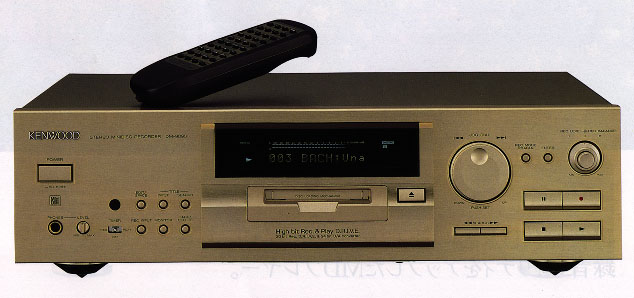Kenwood 9090 Minidisc Deck User Review
Christopher Lloyd ([email protected])
15 Nov 1998

Christopher Lloyd ([email protected])
15 Nov 1998

The Kenwood 9090 Minidisc recorder is Kenwood's top of the range model, above the 5090 and 3090. All have scored very good results in Hi-Fi tests done in the British Hi-Fi magazines. The unit operates in much the same way as the 3090 and 5090 in terms of editing capabilities but its build and sound is, in my opinion, far superior to either.
The first thing you notice upon loading an MD into the deck is the way it accepts the minidisc. Where as the cheaper Kenwood decks and the Sony budget decks such as the 510, 520 and 920 feel fragile upon the insertion of the disc the Kenwood 9090 has a feeling of solidarity about it. The display is large and clear and the remote is half the size of the Sony 510 whilst still maintaining all of the features! Track titling is easier than on the Sonys, with a clearer and more concise method of character selection via the large jog shuttle. This process can be speeded up even more by the purchase of the separately available 'Cybertitler' which is available from Kenwood. This is essentially a keyboard which allows you to type track titles and edit MDs via a remote interface. The deck comes in either black or silver (I chose black) and test mode can be entered in the same way as the Kenwood 1050 (see Minidisc Community Page under 'Hacking'). CD Text can be copied onto an MD but this can only be performed when the CD Text Compatible CD player is of modern Kenwood design as the synchro cable (used as a System Link to link an all kenwood system together) must also be connected between the CD player and MD recorder, in addition to the digital interconnect.
The ATRAC version used is Sony 4.5, and D.R.I.V.E (Dynamic Resolution Intensive Vector Enhancement) is used to record in high quality 20 bit. There are two coaxial digital inputs to the rear as well as an optical, the volumes of which can be adjusted individually to suit. There is an optical and coaxial digital out, also. There is no manual digital level control but this does not matter as there is a very effective digital fader mode on the unit where by, when engaged, whenever recording mode is entered into, or exited from, the unit will fade in or fade out (or both) in a selectable amount of time. I believe the fading is computed logorithmically to make it sound as realistic as possible. The unit has a very useful monitor feature whereby the excellent 24 bit D.A.C can be used independently by any digital input between 32 and 48 Khz sampling rate. There is a timer and a good quality headphone socket with independent volume control on the unit as well as a left-right channel recording balance (something which I have yet to see on any other minidisc recording deck to date(!)).
Recording is very easy thanks to the clear and detailed recording level indicators on the display. There are two of these (selectable between each other) to suit differing dB levels. Mono analogue recording is possible (doubling recording time of disc) and selected input is displayed on the screen complete with current sampling rate. Auto-track marking can be cancelled via the remote. One thing I must point out is that the analogue recording level control is quite fiddley to use (although I don't consider it a problem) and the analogue input is quite insensitive (though fine for radio, CD, MD recordings etc. it can be difficult to get a suitable amount of level when dubbing from quiet parts of analogue tape recordings). As far as I know, there is no way of defeating SCMS on this unit.
The spec. of the Kenwood states that it has a Signal to Noise ratio of more than 110db with a dynamic range greater than 98db. Power consumption is 20W. The unit looks huge beside the rest of my Hi-Fi with its heavy duty metal chassis, weighing in at 5.4kg.
The sound of the Kenwood 9090 is very natural. It does not sound digital, taking away that 'digital' sound and making a recording sound almost like a record! It certainly beats many a CD player on sound. I own the Sony 510 CD Player (a sub GBP 200 award winner) and the Kenwood sounds significantly better than that. If you like your music natural and musical, buy the Kenwood. It is just as excellent for recording as it is for playback.
I purchased this unit from SevenOaks Hi-Fi in Sheffield, U.K. After making some telephone enquiries at various stores SevenOaks gave the most reasonable quote at GBP 450 (not bad for a GBP 550 recorder!). The unit handles very well, being very heavy and well built, and I feel that I could never want for any facility that this machine does not already offer.